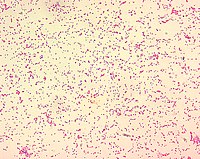
Photo from wikipedia
Brucellosis, caused by several species of the genus Brucella, is a zoonotic disease that affects humans and animal species worldwide. Information on the Brucella species circulating in different hosts in… Click to show full abstract
Brucellosis, caused by several species of the genus Brucella, is a zoonotic disease that affects humans and animal species worldwide. Information on the Brucella species circulating in different hosts in Kenya is largely unknown, thus limiting the adoption of targeted control strategies. This study was conducted in multi-host livestock populations in Kenya to detect the circulating Brucella species and assess evidence of host–pathogen associations. Serum samples were collected from 228 cattle, 162 goats, 158 sheep, 49 camels, and 257 humans from Narok and Marsabit counties in Kenya. Information on age, location and history of abortion or retained placenta were obtained for sampled livestock. Data on age, gender and location of residence were also collected for human participants. All samples were tested using genus level real-time PCR assays with primers specific for IS711 and bcsp31 targets for the detection of Brucella. All genus positive samples (positive for both targets) were further tested with a speciation assay for AlkB and BMEI1162 targets, specific for B. abortus and B. melitensis, respectively. Samples with adequate quantities aggregating to 577 were also tested with the Rose Bengal Test (RBT). A total of 199 (33.3%) livestock and 99 (38.5%) human samples tested positive for genus Brucella. Animal Brucella PCR positive status was positively predicted by RBT positive results (OR = 8.3, 95% CI 4.0–17.1). Humans aged 21–40 years had higher odds (OR = 2.8, 95% CI 1.2–6.6) of being Brucella PCR positive compared to the other age categories. The data on detection of different Brucella species indicates that B. abortus was detected more often in cattle (OR = 2.3, 95% CI 1.1–4.6) and camels (OR = 2.9, 95% CI 1.3–6.3), while B. melitensis was detected more in sheep (OR = 3.6, 95% CI 2.0–6.7) and goats (OR = 1.7, 95% CI 1.0–3.1). Both B. abortus and B. melitensis DNA were detected in humans and in multiple livestock host species, suggesting cross-transmission of these species among the different hosts. The detection of these two zoonotic Brucella species in humans further underpins the importance of One Health prevention strategies that target multiple host species, especially in the multi-host livestock populations.
Journal Title: Scientific Reports
Year Published: 2021
Link to full text (if available)
Share on Social Media: Sign Up to like & get
recommendations!